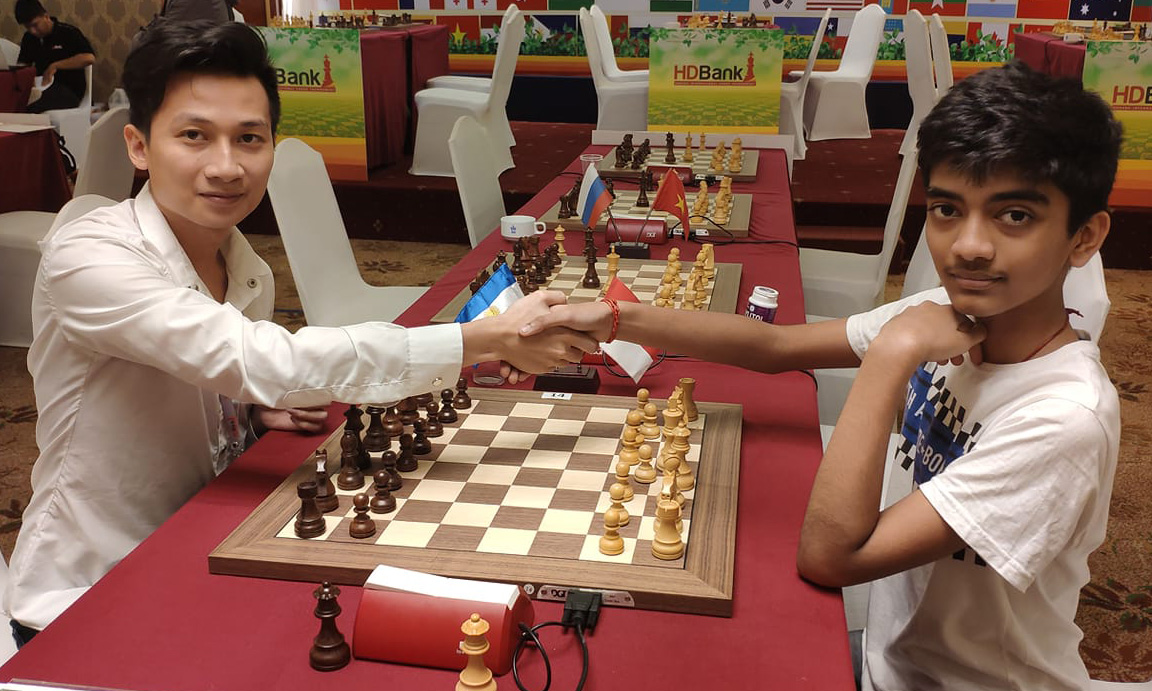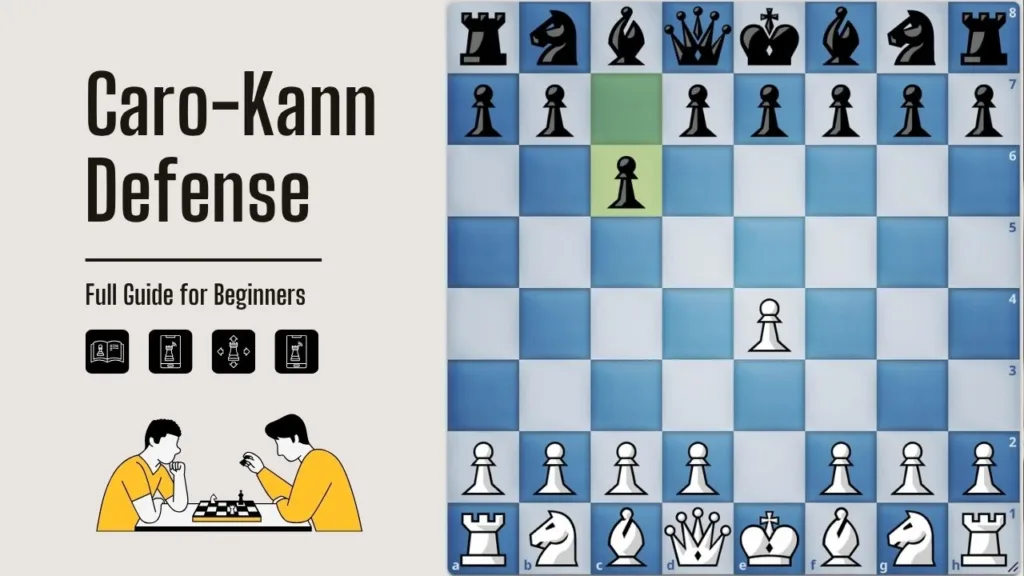The Caro–Kann Defense (1.e4 c6) is one of chess’s most respected shields against 1.e4. Favored by world champions from Capablanca to Ding Liren, it offers Black a solid yet flexible way to meet White’s king’s pawn opening.
While it doesn’t seek chaos in the early moves, it can lead to rich middlegames and even sharper fights if either side pushes the right ideas. In this guide, we’ll cover all major variations, from the timeless Classical to the surprise-packed Fantasy, so you’ll know exactly how to handle it as White or Black.
The Caro–Kann begins with:
1. e4 c6
White pushes the king’s pawn two squares.
White’s aim: grab space in the centre, open lines for the queen and bishop, and prepare d4 for full control.
Black replies with c6.
Black’s aim: prepare …d5 to challenge the centre, without blocking the light-squared bishop like in the French Defense.
- Why Choose the Caro–Kann?
- Main Move Order: 1.e4 c6 2.d4 d5
- 1. Classical Variation – The Old Master’s Way
- 2. Modern Variation – A Flexible Setup
- 3. Advance Variation – Pushing Forward
- 4. Exchange Variation – Symmetry but Not Peace
- 5. Panov–Botvinnik Attack – Fast Play, Isolated Pawn
- 6. Fantasy Variation – Surprise Weapon
- 7. Rare but Tricky Lines
- Plans in the Caro–Kann
- Why It’s Loved by Champions
Why Choose the Caro–Kann?
If the Sicilian is like a street fight and the French is like a fortress, the Caro–Kann is like a well-built shield.
It’s solid.
It’s reliable.
It’s loved by players who don’t want to take wild risks early.
Black often reaches safe endgames with a strong pawn structure.
White often gets more space but must work hard to break Black’s defense.
Main Move Order: 1.e4 c6 2.d4 d5
White plays d4.
White’s aim: claim full central space with two pawns side by side.
Black pushes d5.
Black’s aim: challenge White’s centre right away.
From here, White has many choices, each leading to a different kind of fight.
1. Classical Variation – The Old Master’s Way
Moves: 3.Nc3 (or 3.Nd2) dxe4 4.Nxe4 Bf5
White develops the knight.
White’s aim: recapture on e4, keep a strong centre, and start development quickly.
Black exchanges on e4 and develops the bishop to f5.
Black’s aim: place the bishop outside the pawn chain before …e6, keeping it active.
This is the “Capablanca style” Caro–Kann, calm but powerful.
White may attack with h4–h5.
Black will strike back with …c5 at the right time.
The Classical Variation of the Caro–Kann, marked by the early …Bf5, remains the most popular choice even in 2025. On Lichess, around 43% of players choose it, and among master-level games, the number climbs to 56%. Despite its “classical” label, it’s very much a modern favorite, offering active piece play, a solid structure, and clear development plans. Its enduring popularity shows that sometimes the old ways still work best.
Note: If Black plays 4…Nf6, you can try to counter with the Alien Gambit, just for fun.
2. Modern Variation – A Flexible Setup
Moves: 3.Nc3 dxe4 4.Nxe4 Nd7
White takes the centre as usual.
White’s aim: develop smoothly, maybe push h4–h5 if the bishop goes to g6.
Black plays Nd7 instead of Bf5.
Black’s aim: avoid early targets, exchange knights on f6, and keep the bishop flexible.
It’s solid but gives White more space early.
White can try the tricky 5.Ng5 or 5.Qe2 aiming at f7.
Do you know: The Modern Variation of the Caro–Kann, also known as the Karpov Variation, gained its name from Anatoly Karpov, who used it repeatedly and successfully during his reign as World Champion in the late 20th century. It was called “modern” to distinguish it from the older Classical lines that dominated the early 1900s.
In this variation, Black develops more cautiously with …Nd7 instead of the immediate …Bf5, aiming to avoid early piece exchanges that could create weaknesses. During Karpov’s era, this slow, patient style fit perfectly with his positional mastery, allowing him to neutralize aggressive opponents and slowly outplay them in the middlegame. While still sound, the Karpov Variation is seen less often in today’s elite tournaments, as modern grandmasters often prefer more active counterplay from the opening.
3. Advance Variation – Pushing Forward
Moves: 3.e5
White locks the centre immediately.
White’s aim: gain space, push Black’s pieces back, and prepare kingside play.
Black has two main replies:
- 3…Bf5 – develop the bishop before locking it in.
Black’s aim: control e4 and prepare …e6 and …c5. - 3…c5 – strike the centre quickly.
Black’s aim: create counterplay, especially on the weak d4 pawn, before White settles in.
This variation can be sharp, especially with moves like g4 from White at some time. It’s called Van der Wiel attack, or Nunn-Shirov attack. It’s is a favorite of aggressive, “all-or-nothing” players. First seen in the 1980s with GM John Nunn and later popularized by Alexei Shirov, it begins with the bold 5.g4, tearing open White’s own kingside in exchange for immediate activity and open lines. White typically follows up with Nc3, meaning that once Black strikes with …c5, the central d4-pawn will lack the c3-pawn’s support.
After clearing the center by trading the d-pawn for Black’s c-pawn, White has two main plans:
- Knight to f4 – targeting the g6-bishop and preparing a sacrifice on d5, often with the setup Bg2, Qe2, and long castling. Anand’s win against Shirov is a model for countering this plan.
- Knight to d4 – supporting a pawn storm with f4 and f5. Check out this masterpiece from the great John Nunn
4. Exchange Variation – Symmetry but Not Peace
Moves: 3.exd5 cxd5
White swaps pawns early.
White’s aim: get an open game, simple development, and target Black’s d5 pawn later.
Black keeps a symmetrical structure.
Black’s aim: avoid weaknesses and wait for middlegame chances.
White can play Bd3 early to stop …Bf5, or go for the Panov–Botvinnik Attack with c4 for an IQP structure and attacking chances.
In the Caro–Kann, the Advance Variation (3.e5) is White’s top choice, played in 39% of games on Lichess and 38% at master level. The Exchange Variation (3.exd5) comes second among Lichess players at 31%, but drops to third among masters with 20%. Meanwhile, the 3.Nc3 line ranks third for Lichess users at 20%, yet rises to second place among masters with 24%.
5. Panov–Botvinnik Attack – Fast Play, Isolated Pawn
Moves: 3.exd5 cxd5 4.c4
White hits the centre with c4.
White’s aim: get quick development and attacking chances, even if it means taking on an isolated pawn later.
Black develops with …Nf6 and …e6.
Black’s aim: block the isolated pawn and use it as a target in the endgame.
The main line is: 1. e4 c6 2. d4 d5 3. exd5 cxd5 4. c4 Nf6 5. Nc3 e6 6. Nf3 Bb4
The Panov–Botvinnik Attack embodies White’s philosophy of bold ambition over cautious restraint. By exchanging on d5 early, White opens the position, quickly mobilizing the pieces to seize the initiative. In the short term, this grants White active play and pressure across the board, often centered on the d-file and kingside activity. However, this comes at a long-term cost: structural weaknesses, most notably the isolated d-pawn or sometimes hanging b- and c-pawns. These imbalances define the character of the middlegame and endgame.
For Black, the key defensive resource is control over the d5-square, which acts as a strategic anchor from the opening onward. The battle here is a true clash of philosophies: White seeks dynamic, short-term pressure, while Black relies on static, long-term advantages that often become decisive once the middlegame complications subside. The formula for success is simple but not easy, trade off White’s most active pieces, keep the king safe, and guide the game toward an endgame where the pawn weaknesses become a liability.
It’s also worth noting that the Panov–Botvinnik creates some of the most open positions you’ll see in the Caro–Kann, a sharp contrast to the more familiar closed or semi-closed structures Caro–Kann players often prefer. The openness can feel uncomfortable at first, but with experience and confidence in Black’s underlying solidity, the discomfort fades, and the line can become a welcome testing ground for your defensive skill. Survive the middlegame, and by move 40, the chances are high you’ll be pressing for a win, or at least steering the game to safety.
You can see how Gata Kamsky (as White) used this attack to beat Anatoly Karpov in one of the games from 1996 FIDE World Chess Championship:
6. Fantasy Variation – Surprise Weapon
Moves: 3.f3
The Fantasy Variation (3.f3) lives up to its name, it’s a true surprise weapon. For White, it actually delivers the best winning chances in the Caro–Kann. On Lichess, it scores 53% wins to 44% losses, and even at master level it holds a solid 38% win versus 30% loss record. It’s sharp, it’s unexpected, and it can catch Black completely off guard. If you like keeping your opponent guessing, this is our top recommendation, a special pick just for you.
White strengthens e4 and prepares to expand.
White’s aim: take Black out of preparation and keep full control of the centre.
Black can respond with …dxe4 or …e6.
Black’s aim: challenge the centre before White builds too much momentum.
For Black. Hear Hear. The Fantasy Variation (3.f3) is already a surprise weapon, but there’s an even more mischievous twist: Jobava’s oddball 3…Qb6!?. This early queen sortie has been driving Fantasy Variation fans into fits of theoretical frustration. At the time of writing, most White players still seem unsure how to meet it, and their results show it. White’s score dips below 50% when faced with this move.
The idea is disarmingly simple:
- White must play Be3 at some point, but if the bishop moves too soon, the b2 pawn hangs. This means development can get awkward.
- There’s also the nasty threat of …e5!, and if White responds with dxe5, then …Bc5 hits both the g1-knight and the f2-square at once.
What makes 3…Qb6!? so appealing for Black is that there’s no thick theory book to memorize. The position is sharp, but the play is guided by clear concepts rather than endless computer lines. You just follow the ideas, like a dog hearing the tone of a voice rather than the exact words. And the game often plays itself.
7. Rare but Tricky Lines
- Gurgenidze Variation: 3.Nc3 g6 – Black fianchettos the bishop, eyeing d4 pawn.
- 3.Nc3 a6: A waiting move, aiming for …Bg4 later.
These aren’t the main roads, but they can catch unprepared players.
Plans in the Caro–Kann
For White:
- Get space in the centre.
- Develop pieces actively.
- Use kingside pawn storms in Advance or Classical lines.
- Target Black’s c6 and d5 pawns.
For Black:
- Stay solid and patient.
- Break with …c5 at the right time.
- Avoid weaknesses in pawn structure.
- Trade into favourable endgames.
Why It’s Loved by Champions
World champions like Capablanca, Botvinnik, Karpov, and more recently Ding Liren have trusted the Caro–Kann.
It’s not flashy, but it wins games by being hard to break.
If you like playing the long game and frustrating aggressive opponents, this might be your opening.

I’m Xuan Binh, the founder of Attacking Chess, and the Deputy Head of Communications at the Vietnam Chess Federation (VCF). My chess.com and lichess rating is above 2300. Send me a challenge or message via Lichess. Follow me on Twitter (X) or Facebook.

